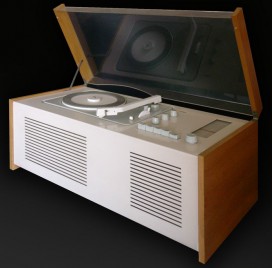 Dieter Rams is celebrated for his work with the German consumer products company, Braun. Up until his retirement in 1998, he designed many monumental products, many of which have found a home on display in the New York Museum of Modern Art. Jonathan Ive, Apple's very talented and successful design chief has cited Rams as one of his primary sources of inspiration. Rams' style can be clearly recognized in Apple's industrial designs. Rams lived by a well-practiced motto, that provides a foundation for solid design of all kinds: "Weniger, aber besser." Less, but better.
Dieter Rams is celebrated for his work with the German consumer products company, Braun. Up until his retirement in 1998, he designed many monumental products, many of which have found a home on display in the New York Museum of Modern Art. Jonathan Ive, Apple's very talented and successful design chief has cited Rams as one of his primary sources of inspiration. Rams' style can be clearly recognized in Apple's industrial designs. Rams lived by a well-practiced motto, that provides a foundation for solid design of all kinds: "Weniger, aber besser." Less, but better.
That motto is the overarching principle behind his brilliant 10 Principles of Good Design. He states that good design:
— is innovative.
Pixar is well known for its beautiful and entertaining films, but it is also an innovative force in the animation field. Why? John Lasseter, Pixar co-founder, preaches frequently that art challenges technology, and technology inspires art. In almost every case in history, artists who fought technological integration were left behind and outshined by those who embraced and harnessed it to move up to the next level.
I can think of few industries where this principle is more applicable than web design. Technology is an indespensible part of what we do. Don't fight technoloy, love it. I've met graphic designers who proudly announce that they can't code worth beans, as though it verifies their authenticity as designers. I disagree with that sentiment. Those technological challenges are exactly what spark my ideas most of the time. I think web designers who code well develop more robust problem solving abilities. Creative thinking is about solving problems with the help of limitations.
— makes a product useful.
This battle has been raging since the dawn of time itself. The fact of the matter is, design must give priority to usability. Fine artists can get away with all kinds of ergonomic crimes, but that's not what designers are. We create beauty with a purpose. Not just for the sake of beauty alone.
— is aesthetic.
Good usability does not, however, preclude beauty. In fact, attractive design is a principle of usability. It's a part of the user experience. If a person doesn't enjoy the experience, they may not use it at all! Careful consideration must be given to the aesthetic value of a product to gain customer loyalty. The guts of a Mac are essentially the same as every other computer, but Apple's careful attention to the experience created by both the hardware and software is what has made it a premium brand.
— makes a product understandable. The purpose of the user interface is to make getting things done as painless as possible. There are a lot of standards that have been established from years of user interaction that users are accustomed to. Certain icons and words tell users exactly what it will do. Straying from those norms is a dangerous road to travel. That shouldn't prevent you from being creative. There's nothing wrong with being different as long as the function is clear from the get go and the learning curve is gentle. Pick the least computer-literate person you know and ask them to accomplish common tasks with your site. You will quickly recognize weaknesses.
The purpose of the user interface is to make getting things done as painless as possible. There are a lot of standards that have been established from years of user interaction that users are accustomed to. Certain icons and words tell users exactly what it will do. Straying from those norms is a dangerous road to travel. That shouldn't prevent you from being creative. There's nothing wrong with being different as long as the function is clear from the get go and the learning curve is gentle. Pick the least computer-literate person you know and ask them to accomplish common tasks with your site. You will quickly recognize weaknesses.
— is unobtrusive.
Your design must stay out of the user's way. Know what your goal is with each page, what you want the user to do, and don't do anything to detract from emphasis on that interaction. Avoid excessive decoration. Blinking, vibrating an neon colors should be used sparingly and with a specific purpose in mind.
— is honest.
Is the message your design portrays consistent with the calibur, integrity and value of the product or service it portrays? Don't play the manipulation game. We want our sites to put the organizations they represent in the best light possible, but if you build up their expectations by creating a false sense of value or function, users will leave ultimately dissatisfied and less likely to return.
— is long-lasting.
Immortality in design. Is it possible, or just every designer's pipe dream? Web Design may be the most difficult design niche to achieve this in, because our field is so inseparable from the technology that drives it. By following the universal design fundamentals, you can avoid annual re-design projects that become necessary when you include trendy and faddish gimmicks in your designs. Line, shape, value, alignment, contrast, scale etc. are timeless design principles that, when carefully considered, make for solid, long-lasting designs.
— is thorough down to the last detail.
Laziness shows. Consistency in your design, attention to details, little things like even margins on all sides, consistent link appearance and behavior throughout your site — these are the little things that will make or break you. Go to the effort to be precise. Follow "best practice" standards from the start. Be just a little obsessive about your crafstmanship.
— is environmentally friendly.
While our environmental impact is more indirect than other design fields, there are still matters of efficiency and footprint we need to take into consideration. On the web that comes primarily in the form of download times and universal compatibility — probably the two things that cause the most headaches in web design. Minimize the bandwidth your site requires. It's better for you and your users; we both have to pay for the traffic it causes. Do your best to create a great experience for all of your users independent of browser, operating system and screen size. Make reasonable accomodations for those with disabilities. It's not that hard to make your site semantic and descriptive.
— is as little design as possible.
Ouch. Offended? Is that a threat to your job security? I don't think so. Rams is only re-emphasizing his guiding principle: "Less, but better." Eliminate the non-essentials. Over-design is not design at all, it's decoration. There's a difference. This hearkens back again to the form vs. function thing. The distinguishing difference between designers and other fine artists and decorators is the purpose the design serves. Our greatest challenges come in the marriage of usability and beauty. You ought to have a real hard think if you find yourself tempted by the addition of an element that brings no additional, essential function to your site.
Dieter Rams is deserving of the respect he's gained as a master designer. Do what he says, and learn first hand what makes great designs great.